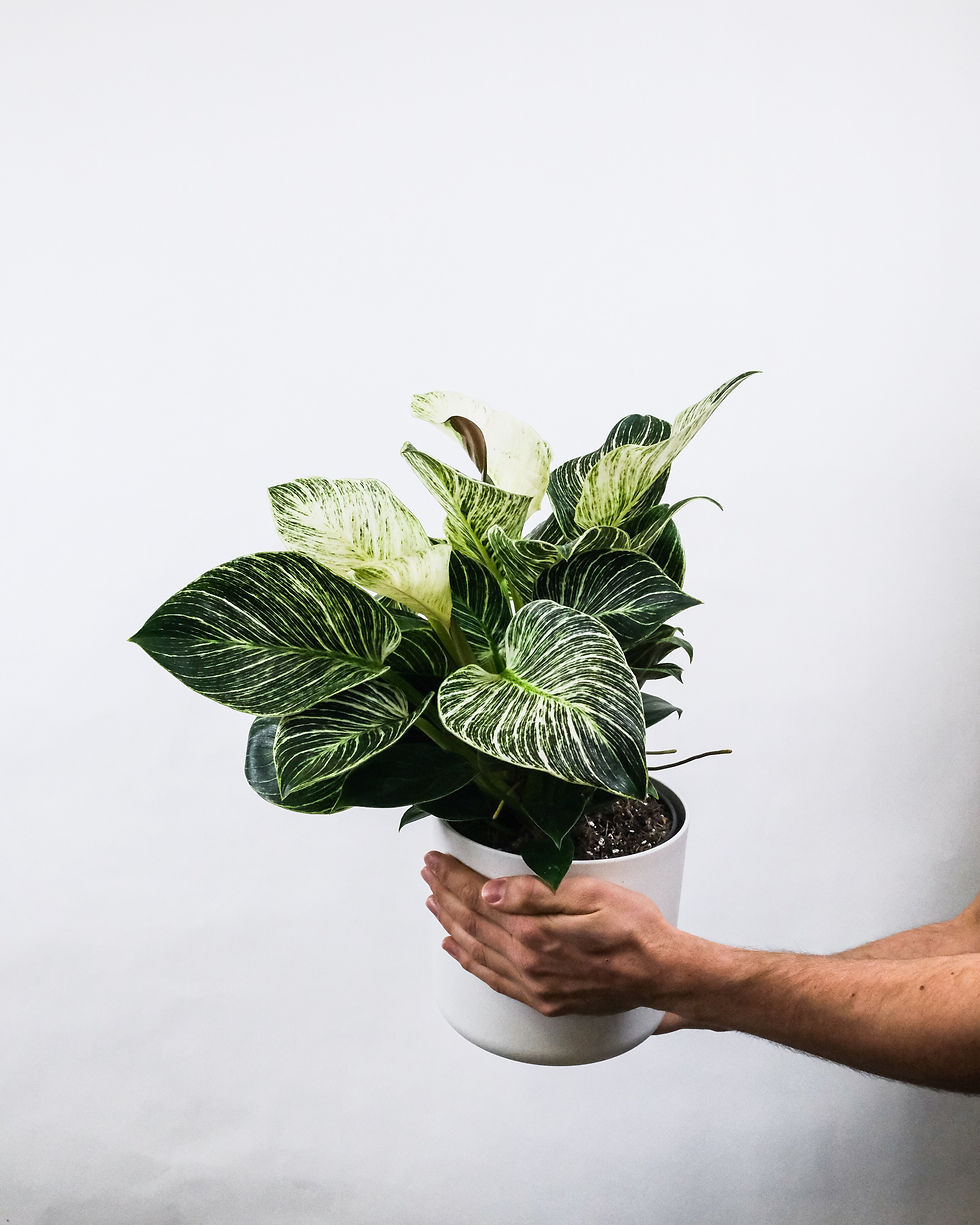Care Guide: Philodendron Birkin
- Harleigh Reimer
- Jul 15, 2024
- 4 min read
If you ever wanted to tell your friends you bought a Birkin, here is your chance.
Unlike the bag, the Philodendron Birkin won't cost you your annual salary - this stunning hybrid variety shows off variegated leaves, without the variegated price tag! Compact, slow-growing, and relatively easy to maintain, it stands out with its round, deep green leaves and vivid white pinstripes and variegation. No two leaves are alike, and its bright, thick stems ensure an upright, clumping growth pattern.
Origins of the Philodendron Birkin
Philodendrons are fascinating plants that belong to a genus with an impressive 489 species. These plants are particularly well-suited to thrive in tropical and humid climates, where their large, striking leaves can grow abundantly. While most philodendrons are known for their climbing abilities, others are 'clumping plants' which will fill out the pot rather than try to find a pole to climb.
The Philodendron Birkin originated from a 'chimeric mutation' that occurred in the Philodendron Rojo Congo variety,
Is a Philodendron Birkin a hybrid?
Interestingly, Birkins do not occur naturally in the wild, as they are a result of human intervention through propagation methods. When the specific Rojo Congo mutation is propagated, it will retain its unique variegated patterns leading to the creation of a new strain we call Birkins! So, in essence, owning a Philodendron Birkin means having a plant that is a product of careful cultivation and breeding.
Light
Direct sunlight is detrimental to Birkins, causing leaf burn and damage. They thrive in bright indirect light or shaded sunlight. A perfect spot is behind a thin curtain near a sunny window or on an east-facing windowsill. Rotate the plant every few weeks to avoid lopsided growth. Under the right light, the pinstripes on the leaves turn bright white, enhancing their beauty!
They will not do well in low light, often resulting in mutated growth, tiny leaves or rotted stems.
Water Requirements for Phildendron Birkins
Always check the soil before you water - only once the top few inches of soil have dried out should you give your plant a drink. Overwatering will lead to rotting stems and leaf loss.
Did you know? Calathea are incredibly fussy when it comes to quality of water. Tap water can have chemicals like fluoride or chlorine which our rainforest-dwelling Calathea will not respond well to. Filtered water is much kinder but rainwater is the best. Always put your plant out in a rain-shower!

Humidity & Temperature
Originating from rainforests, Philodendrons prefer high humidity and won't be happy sitting near air-conditioning or cold drafts. In winter, use a humidifier or a pebble tray filled with water to maintain ambient humidity.
Growth Habits of Birkins
Indoors, Birkins typically grow between 30cm to 60cm tall and clump out rather than growing upwards. They are slow growers, making them suitable for long-term display in decorative pots. Regularly clean the leaves and replenish the soil with nutrients to encourage healthy growth.
Tips for Making Your Birkin Bushier
Pinching: Gently pinch the tips of the stems to encourage branching.
Propagation: Root stem cuttings in water or soil to create new plants.
Repotting: Use a slightly larger container with fresh soil to promote growth.
Lighting: Provide bright, indirect light for strong, healthy growth.
Pruning: Remove yellow, brown, or damaged leaves regularly.
Loss of Variegation
If your Birkin starts producing non-variegated leaves, cut back to the last variegated leaf to encourage new variegation. Ensure the plant receives plenty of bright, indirect light to encourage the variegated growth.
Pests to watch for
While they are not immune, they are a little more resilient to pests than other varieties.
The most common to watch for are mealybugs or spider mites, particularly if your plant isn't in a well-ventilated area.
Just like with any of your indoor plants, check regularly! If you notice multiple leaves deformed or yellowing, chances are you have an infestation. Our Mineral Oil is fantastic for eradicating an infestation, plus is doubles as a leaf shine to keep your plants clean and looking amazing.

Toxicity
Philodendrons contain calcium oxalate crystals, which are toxic to humans and pets so best to keep them away from any pets that may be inclined to taste them.
Soil
Birkins thrive in nutrient-rich, well-draining soil that retains some moisture so use a mix that includes perlite for added drainage. Repot only when the plant tells you (ie roots coming out from the bottom) using fresh, well-draining soil. Only slightly increasing the pot size each time. Don’t go too big too fast or your Birkin will be stressed!
Fertiliser and Propagation
Regularly trim dead or yellowed growth to keep your plant healthy. If you want to propagate, this can be done by dividing the plant during repotting in the spring. Separate the roots and repot the divided plants, caring for them as usual until new growth appears. Fertilise monthly during the growing season (Spring & Summer) with a good liquid fertiliser - such as our Plant Coffee! Simply add a few drops in your watering can when you water - your plants will thank you for it!
Want one?
Want to know more?
Keen to learn more about your houseplants? Come along to our next Indoor Plants 101 workshop for a crash course in everything you need to know about keeping your plants happy and healthy.
None in the calendar? Sign up here be the first to know about upcoming workshops.
















Comments